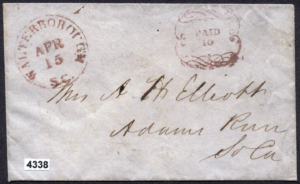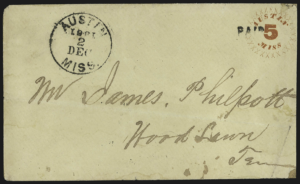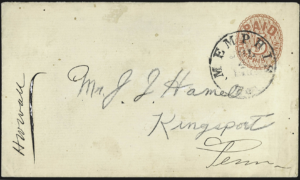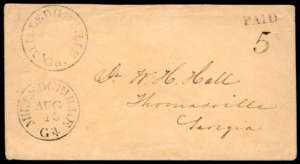When the mail system in the Confederate States was taken over by the new government on 1 June 1861, no stamps were available. It would be several months before the first stamps would be printed and distributed. It was left to the local postmasters to come up with a way to indicate the postage paid on letters posted at their offices.
The most common method used was to require individuals to bring their letters to the post office, where a clerk would collect the postage and mark the letters paid, as was the custom before the introduction of stamps. This was a great inconvenience for everyone because they had grown accustomed to using stamps.
As a matter of convenience and to meet the demands of businesses some postmasters had their own stamps or postal stationery printed. Other postmasters stamped as “paid,” envelopes brought to them with the intention they could be used later as postal stationery. What makes these stamps, and envelopes unique is that they were prepared and paid for in advance of their actual use. These are known as postmasters’ provisionals.
Provisionals have one characteristic in common. They were only valid for postage at their town of origin. There are very few examples of a provisional from one town being recognized as postage at another town. Another characteristic of provisionals is that almost all were only used during the first year of the war: 1 June 1861 to 1 June 1862. Most uses ended by the spring of 1862.
Postmasters of a small number of towns also prepared both adhesive and stampless provisionals during the period between a state’s secession and the takeover of the postal system by the Confederacy. These provisionals reflect U.S. postage rates.
Adhesive and Printed Provisional Envelopes
A relatively small number of postmasters prepared adhesive provisionals. Their design and quality vary considerably with those from larger towns normally being of better quality than those produced by postmasters of smaller towns. Some resemble actual postage stamps while others are merely a paid marking on a small piece of paper. The differences are seen in the illustrations below.

An even smaller number of postmasters prepared printed provisional envelopes. These provisionals can also resemble actual government prepared postal stationery while others are somewhat crude in design. In some cases, it is difficult to tell whether the design was handstamped or printed. New research may reveal some of these were actually handstamped. The differences are seen in the illustrations below. If there is any doubt, the collector should consult the Confederate States of America Catalog and Handbook of Stamps and Postal History (CSA Catalog), pages 245-312.
Click any image to enlarge
Stampless provisionals are envelopes handstamped with a paid and rate marking by a postmaster or clerk and returned to the customer for future use. How can one tell such an envelope from an ordinary stampless cover? The acid test is whether the envelope was prepared and paid for in advance of its actual use.
Some stampless provisionals markings are found on unused covers. These are proof that these markings were prepared in advance of actual use. A corollary to this is a general issue used over a stampless marking. If the only postal use of the cover is with the stamp, this is proof the handstamped markings were unused prior to the application of the general issue stamp.
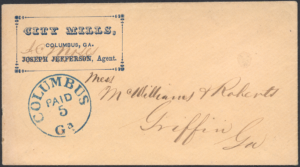
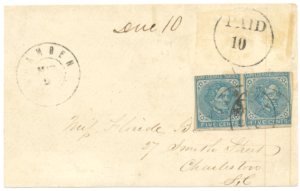
Some postmasters incorporated security feature on the envelopes they marked as paid. These features take the form of dated or undated postmarks or some other marking applied to the front or back of an envelope. Such controls validated the prepayment of postage on envelopes left at a post office. Other postmasters indicated the prepayment by using a different color ink than normally used for paid markings. Finally, some stampless provisionals have been recognized based solely on their fancy design. Examples of these different types of stampless provisionals are illustrated below.
All the accepted stampless provisional envelopes are listed in the 2012 CSA Catalog pages 245-312.
